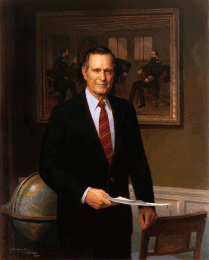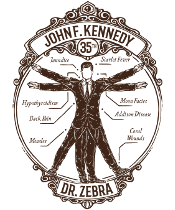

Health and Medical History of President
George BushLived 1924-2018
Health and Medical History of President
George BushLived 1924-2018
1776-1783
1812-1815
1846-1848
1861-1865
1898-1899
1917-1918
1941-1945
1950-1953
1964-1975
1990-1991
2001-2021

A "sebaceous cyst" on the third finger of his right hand had been drained at the time of his physical five months earlier. The cyst, undoubtedly the same as the one removed, had been present for many years 5a.
Bush was transferred to Bethesda Naval Hospital by helicopter. His ventricular rate was 150/min 1e. Cardiologist Dr. Allen M. Ross prescribed digitalis, procainamide, and Coumadin 7. (Note: Digitalis slows the heart, procainamide can change the rhythm pattern from atrial fibrillation back to normal, and Coumadin prevents blood clots, one of the main complications of atrial fibrillation.) Abrams writes:
According to the doctors' plan, if the drugs failed to affect the arrhythmia -- as initially they did -- an electrical shock would be administered the following day, a common way of returning a patient's rhythm to normal. When it was announced that Dan Quayle would be acting president under the Twenty-fifth Amendment provisions while Bush was under anesthesia for the cardioversion -- if it was required -- a different kind of shock reverberated across the nation. The prospect of Quayle as president brought home sharply the electorate's lack of confidence in his ability to lead. 3bThe drugs were effective. By 10:25 pm on May 5, Bush's heart rhythm was normal. About 5 am the following morning, however, atrial fibrillation recurred. It was decided (by whom?) to continue the drugs rather than use electrical cardioversion. Bush returned to the White House later that day. 3b. Comment: It would be useful to have information on how long Bush used these medications. Both digitalis and procainamide can affect higher mental function.
"President Bush and the team of physicians caring for him agreed that his hyperthyroidism should be treated in the safest, fastest, most definitive, and permanent way possible. Therefore, he took an oral dose of radioactive iodine a few days after being admitted to the hospital" 7. Two days later Bush began a ten day course of potassium iodide (SSKI), four drops three times a day, to prevent a rare complication of radio-iodine therapy called "thyroid storm" (extreme hyperthyroidism).
The treatment worked. "Within a few months" Bush's thyroid was no longer over-producing thyroid hormone. In fact, it was now producing too little (a common occurence after radiation treatment). Thus, Bush began taking, for the rest of his life, a pill containing synthetic thyroid hormone known as "Synthroid" 7.
Comment: For a few days, radio-iodine treatment generally makes the patient radioactive to a degree that can jeopardize others who come too close. For this reason, such treatments are generally given in the hospital. Lower levels of radiation persist longer, however. As far back as 1986 the White House contained radiation detectors 8. It would be interesting to know whether the detectors had to be turned off or re-calibrated after Bush had his radiation treatment. It would also be interesting to know how physical access to the President was controlled while he was radioactive.
Watching a few semi-candid clips of Bush from October 1992 9 only strengthens an impression of mental lassitude MORE. Asked by Larry King what disease he (Bush) had just had, Bush replied "Crohn's? No, not Crohn's. Uh, just thyroid." An apathetic- and listless-appearing Bush also seemed to think that Halcion (a sleeping pill he had taken) was a decongestant. Comment: Either Bush was amazingly ignorant of his medical issues, or he was not firing on all cylinders.
The Bush dog, Millie, came down with Graves disease, too 10, although there are reports Millie had a different auto-immune disease: lupus 7.
Because of the remarkable coincidence of three cases of auto-immune disease in one household, the Secret Service tested the water in the White House, at Camp David, at the Vice President's residence, and at Walker's Point (Bush's home in Maine) for lithium and iodine, two substances "known to cause thyroid problems" 5e. MORE.
It proved to be nothing more than "the flu," but coming on the heels of Bush's diagnoses of atrial fibrillation and Graves disease in the preceding 12 months, there was concern over his physical health MORE.
Comment: During the episode Bush had the appearance of a man suffering an inferior-wall myocardial infarction. An electrocardiogram was, however, normal. It's not clear what the Japanese Prime Minister thought of all this. One is left to ponder the immortal line from the immortal movie Animal House: "Flounder, you didn't just throw up in front of Dean Wormer, you threw up on Dean Wormer!"
Interestingly, Bush's son George W. Bush also suffered a syncopal episode while President.
Listening to him discuss Halcion with Larry King, it seems that Bush was a fan of the medicine MORE.
- Bush's dog would get "psychosomatically paralyzed, any time George and Bar went away" 13a.
- Sometime in the 1996-2002 range, Bush's personal physician, Dr. Benjamin Orman, declared: "Mr. Bush does not look his age, is unusually healthy, exercises frequently, and continues to go at a brisk pace" 7.
- Bush's son is George W. Bush. Various web sites say the Bush family is related to the Spencer family, of which Princess Diana of Wales was a member.
- Bumgarner, John R. The Health of the Presidents: The 41 United States Presidents Through 1993 from a Physician's Point of View. Jefferson, NC: MacFarland & Company, 1994.
 a p.288 b p.289 c p.290 d pp.289-291 e p.292 f p.294 g p.295
a p.288 b p.289 c p.290 d pp.289-291 e p.292 f p.294 g p.295Comment: Devotes one chapter to each President, through Clinton. Written for the layperson, well-referenced, with areas of speculation clearly identified, Dr. Zebra depends heavily on this book. Dr. Bumgarner survived the Bataan Death March and has written an unforgettable book casting a physician's eye on that experience.
- Mathews J. The shrinking field. Washington Post. August 3, 1999. Page C1.
Comment: Accessed through washingtonpost.com: http://www.washingtonpost.com/wp-srv/politics/campaigns/wh2000/stories/tall080399.htm
- Abrams, Herbert L. "The President Has Been Shot": Confusion, Disability, and the 25th Amendment in the Aftermath of the Attempted Assassination of Ronald Reagan. New York: W. W. Norton & Company, 1992.
- Jaret, Peter. Blinking and thinking. In Health. July/August 1990; 4(4): 36-37.
- White House Press Release. [various topics]. George H.W. Bush Public Papers. (Kept in the Bush Presidential Library, College Station, TX).
a Statement by Press Secretary Fitzwater on the Results of the President's Physical Examination, May 10, 1989 b Statement by Press Secretary Fitzwater on the President's Hand Surgery, October 6, 1989 c Statement by Press Secretary Fitzwater on the President's Physical Examination, April 12, 1990 d Statement by Press Secretary Fitzwater on the President's Eye Examination, April 25, 1990 e Statement by Press Secretary Fitzwater on the President's Health, May 28, 1991 f Statements by Press Secretary Fitzwater on the President's Physical Examination, March 26, 1992
Comment: Downloaded 26-27 November 2003 from: http://bushlibrary.tamu.edu/papers/
- Heimel, Cynthia. Combover Congress: how can we trust our leaders to manage impeachment when they can't even manage their hair?. Salon.com. Feb. 3, 1999.
Comment: Caveat emptor: no written source for these statements is known to Dr. Zebra. Available on the web at: http://www.salon.com/news/1999/02/03newsb.html
- The Thyroid Society. Graves' disease: the heart of the matter. [On line]. Accessed 16 December 2002.
Comment: See: http://the-thyroid-society.org/graves.html
- Toltzis RJ, Morton DJ, Gerson MC. Problems on Pennsylvania Avenue. N Engl J Med. 1986 Sep 25;315(13):836-7. Pubmed: 3748102.
- Springer, Brian. Spin. [Movie, 1995]. Accessed 6 July 2006.
Comment: This movie is largely composed of clips from 1992 television satellite feeds. These feeds are usually not broadcast in their entirety. For example, satellite feeds can include recordings made during commercial breaks or before a show starts. With the proper equipment, anyone can pick up satellite feeds (although they may be encrypted). 57 minutes 26 seconds. Movie accessed at: http://www.brasscheck.com/videos/spin.html
- Ebner SA, Badonnel MC, Altman LK, Braverman LE. Conjugal Graves disease. Ann Intern Med. 1992 Mar 15;116(6):479-81. Pubmed: 1739238.
- Hedger B. White coats in the White House: Former presidential physicians reflect on their service. AMedNews. Mar. 23, 2009.
Comment: http://www.amednews.com/article/20090323/profession/303239973/4/
- Associated Press. [no title]. Yahoo! News [on-line]. 3 August 2002, 1:40 pm ET.
- Cramer, Richard Ben. What It Takes: The Way to the White House. New York: Random House, 1992.










 0 reviews
0 reviews